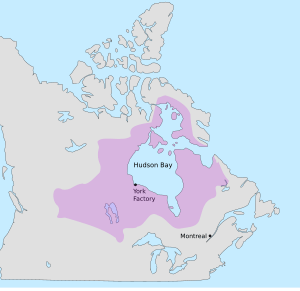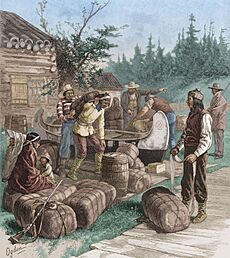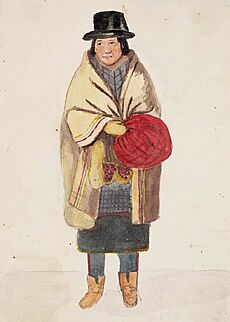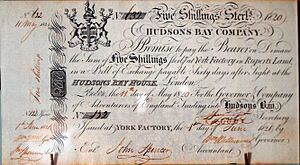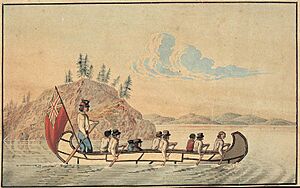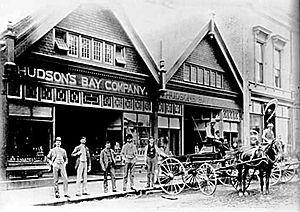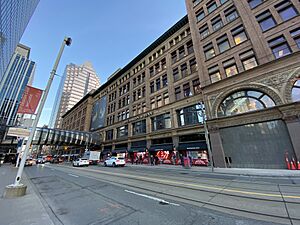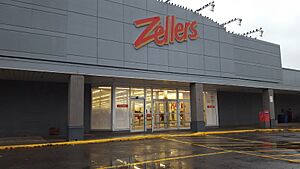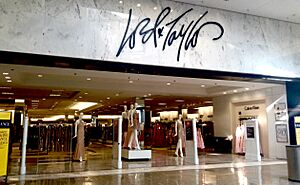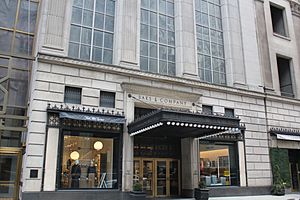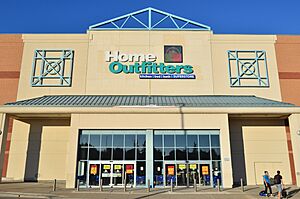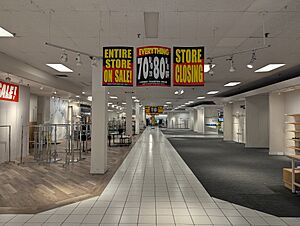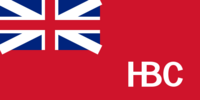Hudson's Bay Company facts for kids
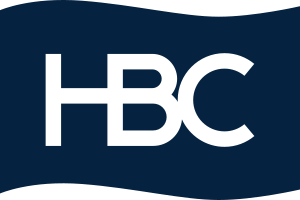 |
|
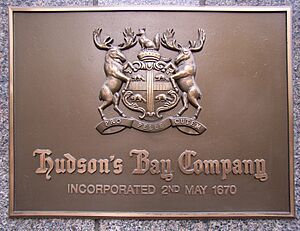
Coat of arms plaque on the exterior of the former flagship store in Downtown Toronto (2007)
|
|
|
Formerly
|
The Governor and Company of Adventurers of England Trading Into Hudson’s Bay |
|---|---|
| Privately held | |
| Industry | Retail |
| Genre | Department stores |
| Fate | Creditor protection and liquidation |
| Successor |
|
| Founded | 2 May 1670 in London, England |
| Founders |
|
| Headquarters | |
|
Areas served
|
Canada |
|
Key people
|
Richard Baker (governor, executive chairman and CEO) |
| Revenue | |
|
Number of employees
|
9,364 (at liquidation, 2025) |
| Parent | NRDC Equity Partners (2008–2025) |
| Subsidiaries | Hudson's Bay (1881–2025)
Previously defunct and/or divested
|
The Hudson's Bay Company (HBC) was a Canadian company that owned department stores and other businesses. It was the oldest company in North America, started in 1670. HBC was based in Toronto and New York City. The company faced financial difficulties and closed down in 2025. Its brand names and logos are now owned by Canadian Tire.
HBC began with a special permission from King Charles II. This permission gave the company the right to trade furs in a huge area called Rupert's Land. This land included all the rivers that flowed into Hudson Bay. For a long time, HBC controlled the fur trade in British North America. It even acted like a government in Rupert's Land until 1869, when it gave control of the land to Canada.
After that, HBC started other businesses, especially retail stores. It opened the Hudson's Bay department stores in 1881. It also owned other popular stores like Home Outfitters, Zellers, and Fields. Over the years, HBC expanded into the United States, owning stores like Lord & Taylor and Saks Fifth Avenue. It also had stores in the Netherlands for a short time.
In 2006, American businessman Jerry Zucker bought HBC. Then, in 2008, a company called NRDC Equity Partners took over. HBC became a public company in 2012, meaning its shares could be bought and sold on the stock market. However, it became a private company again in 2020. In late 2024, HBC separated its American stores into a new company called Saks Global. In March 2025, HBC filed for financial protection. By June 2025, all its stores, including Hudson's Bay and Saks locations in Canada, had closed.
Contents
Early History: The 1600s
For most of the 1600s, French settlers in North America controlled the fur trade. Two French traders, Pierre-Esprit Radisson and Médard des Groseilliers, learned from the Cree people that the best furs were found north and west of Lake Superior. They thought there was a "frozen sea" even further north, which was Hudson Bay. They wanted to set up a trading post there to make it easier to move furs.
The French governor didn't want them to explore this new route because it might move the fur trade away from the St. Lawrence River. But Radisson and Groseilliers went anyway in 1659. They returned to Montreal with many valuable furs, showing how much potential the Hudson Bay area had. However, French authorities arrested them for trading without permission and took their furs.
Determined to trade in the Hudson Bay area, Radisson and Groseilliers asked English merchants in Boston for help. Their first trip in 1663 failed because their ship got stuck in ice. But an English official heard their story and brought them to England to find new sponsors. They arrived in London in 1665 during a terrible plague. Eventually, they met Prince Rupert, who introduced them to his cousin, King Charles II.
In 1668, an English expedition with two ships, the Nonsuch and the Eaglet, set out to explore Hudson Bay. The Eaglet had to turn back, but the Nonsuch continued to James Bay. There, in 1668, they built the first fort on Hudson Bay, called Charles Fort. It was later known as "Rupert House" and is now Waskaganish, Quebec. Both the fort and the river were named after Prince Rupert, who was a main investor and became the new company's first leader.
After a successful trading trip in the winter of 1668–69, the Nonsuch returned to England in October 1669. It carried the first furs from Hudson Bay, which sold for a good price. This showed that the fur trade in Hudson Bay could be very profitable.
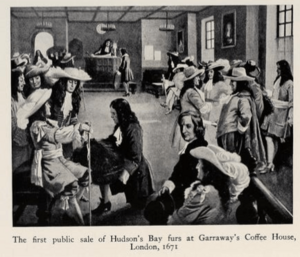
King Charles II officially created "The Governor and Company of Adventurers of England, trading into Hudson's Bay" on May 2, 1670. This special permission gave the company a monopoly, meaning they were the only ones allowed to trade, over the entire region that drained into Hudson Bay. This huge area, named "Rupert's Land" after Prince Rupert, covered more than one-third of modern-day Canada. Its exact borders were not known at the time.
HBC built six trading posts between 1668 and 1717. These included Rupert House, Moose Factory, and Fort Albany on James Bay. Three others were on the western shore of Hudson Bay: New Severn, York Factory, and Fort Churchill. These posts were called "factories" because a "factor," or trading agent, worked there. They traded furs using a system based on the "Made Beaver" (MB), which was a prime beaver pelt. For example, two otter pelts might be worth one Made Beaver.
During the fall and winter, First Nations people and European fur trappers caught animals and prepared the pelts. They traveled by canoe and on foot to the forts to sell their furs. In return, they received goods like knives, kettles, beads, needles, and the famous Hudson's Bay point blanket. The arrival of the First Nations trappers was a big event, with special ceremonies for trading.
The English company's way of trading from coastal forts was different from the French. The French set up many posts inland and sent traders to live among the tribes, learning their languages and often marrying Indigenous women. In 1686, the French sent a raiding party to capture HBC posts along James Bay. Pierre Le Moyne d'Iberville, a brave French leader, became commander of the captured posts.
After 1688, England and France were officially at war, and this conflict spread to North America. D'Iberville attacked Fort Severn in 1690. In 1693, HBC got Fort Albany back, but d'Iberville captured York Factory in 1694. HBC got it back the next year.
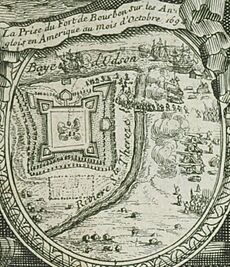
In 1697, d'Iberville led another French attack on York Factory. On the way, he defeated three British ships in the Battle of Hudson's Bay. This was the largest naval battle in the North American Arctic. D'Iberville's smaller French force captured York Factory by pretending to be a much larger army. The French kept most of the posts, except Fort Albany, until 1713. These conflicts caused HBC to lose money and not pay any profits for over 20 years.
The 1700s: Expansion and Competition
When the wars between England and France ended in 1713 with the Treaty of Utrecht, France gave up all its claims to Hudson Bay. The area became British again. After this, HBC built Prince of Wales Fort, a strong stone fort at the mouth of the Churchill River. In 1782, during the American Revolutionary War, a French fleet captured and destroyed York Factory and Prince of Wales Fort to help the American rebels.
HBC traded wool blankets, called Hudson's Bay point blankets, for beaver pelts. By 1700, these blankets made up over 60 percent of their trade. The number of indigo stripes on the blankets showed their size. Many people mistakenly thought the stripes showed their value in beaver pelts.
HBC's control over Rupert's Land was similar to how the East India Company controlled India around the same time. HBC even invested in the East India Company in 1732, seeing it as a major competitor.
HBC's first trading post inland was built by Samuel Hearne in 1774. It was called Cumberland House, Saskatchewan. Other inland posts were built before this, like Henley House in 1743. These posts helped HBC expand its reach into the interior.
In 1779, other traders started the North West Company (NWC) in Montreal. This company was formed to compete with HBC. By 1784, NWC was seriously cutting into HBC's profits.
The 1800s: Rivalry and Growth

The North West Company (NWC) was HBC's main rival in the fur trade. Their competition led to a small conflict called the Pemmican War in 1816, which ended with the Battle of Seven Oaks. In 1821, the British government forced NWC and HBC to merge to stop the violence. Many trading posts were closed because they were no longer needed. The combined company's territory grew, reaching the Arctic Ocean in the north and the Pacific Ocean in the west.
Before the merger, HBC employees didn't share in the company's profits. After the merger, under the leadership of Sir George Simpson, officers like chief factors and chief traders shared in the profits. The company's trade covered a huge area, and it had 1,500 employees.
Between 1820 and 1870, HBC even printed its own paper money. These notes were used mainly in the Red River Colony.
Competition and Exploration
Even with its monopoly, HBC faced competition from independent traders in the Red River Colony. They sold furs to buyers in the United States. Also, Americans controlled the fur trade on the Northwest Coast until the 1830s.
In the 1820s and 1830s, HBC controlled almost all trading in the Pacific Northwest. Its main base was at Fort Vancouver. HBC tried to stop American settlers from moving into the area.
HBC also had an early presence in what is now the United States. They took over NWC sites like Spokane House and Fort Okanogan. In the mid-1820s, Peter Skene Ogden explored south into what is now Utah. Many places there are named after him. HBC also built forts like Fort Boise in 1834 to compete with American traders.
HBC trappers also explored Northern California, going as far south as the San Francisco Bay Area. They even had a trading post in Yerba Buena (now San Francisco). HBC also operated a store in the Hawaiian Islands from 1828 to 1859.
By 1838, HBC reached as far north as Fort Stikine in Alaska Panhandle. They made a deal with the Russian-American Company to supply Russian trading posts with farm products.
HBC's strong control over the region ended when many American settlers arrived in Oregon in 1843. In 1846, the United States gained full control south of the 49th parallel.
Early Presence in British Columbia
HBC also continued NWC's presence in central and northern British Columbia. They had important sites like Fort Alexandria and Fort St. James.
In 1824, HBC sent an expedition to explore the Fraser River. They found a good location for a trading post, and the first Fort Langley was built in 1827. This marked an early, lasting presence of settlers in southern British Columbia. The fur trade there wasn't great, so it quickly became a salmon trading post.
HBC expanded its presence north along the coast with Fort Simpson (1831). They also used the Beaver (1836), the first steamship in the Pacific Northwest, to resupply their coastal posts. By 1837, HBC had a strong hold on the coastal fur trade, keeping American traders away.
By 1843, with the Oregon Treaty border negotiations coming, HBC built Fort Victoria on Vancouver Island. This became their new main base in the region. They also built Fort Rupert (1849) to access coal. On the mainland, Fort Hope and Fort Yale (1848) were built along the Fraser River.
End of the Monopoly
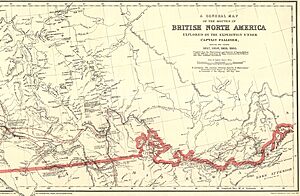
The trial of Guillaume Sayer in 1849 helped end HBC's monopoly. Guillaume Sayer, a Métis trader, was accused of illegal fur trading. A crowd of armed Métis men gathered outside the courtroom. Even though Sayer was found guilty, he wasn't punished. This event, with the cry "Trade is free!", weakened HBC's control over the courts and its monopoly in the Red River area.
Another reason for the end of the monopoly was the Palliser expedition from 1857 to 1860. This expedition explored the prairies and showed that the Canadian West was suitable for farming, which went against what HBC had claimed.
In 1863, a company called the International Financial Society bought most of HBC. The new owners were more interested in land and development than in the fur trade.

In 1869, HBC agreed to give Rupert's Land back to Britain. Britain then gave it to Canada. HBC received money for its losses and kept some land where its trading posts were. This agreement, called the Deed of Surrender, took effect in 1870. The land became the North-West Territories and was added to Canada. This also led to the creation of the province of Manitoba.
During the 1800s, HBC changed a lot. It had to adapt to growing populations and new settlements. It became clear that the company could not continue to control the future of the West.
Shift to Department Stores
The modern department store grew from trading posts in the early 1800s. HBC soon expanded inland, setting up posts that later became cities like Winnipeg, Calgary, and Edmonton. The first sales shop opened in Fort Langley in 1857. More sales shops followed in other cities. The first large "original six" department stores were built in Calgary in 1913, followed by Edmonton, Vancouver, Victoria, Saskatoon, and Winnipeg.
The 1900s: Modernization and Diversification
World War I interrupted HBC's plans to remodel its stores in 1912. After the war, the company improved its fur trade and real estate businesses. It also started to get involved in the oil business. HBC co-founded Hudson's Bay Oil and Gas Company (HBOG) in 1926. Although HBC tried many different areas, its department store business is the only part that remained, under the Hudson's Bay brand. The company also opened new trading posts in the Canadian Arctic.
Indigenous Health Concerns
In 1927, medical scientist Frederick Banting traveled in the Arctic. He noticed that people on an HBC ship were spreading the influenza virus, which was devastating the Indigenous population. Banting told a reporter that HBC's fur trade practices were unfair to Indigenous people. He said that for over $100,000 worth of fox skins, Indigenous people received less than $5,000 worth of goods. He also linked this to poor health, saying their diet became "flour, sea-biscuits, tea and tobacco."
HBC leaders were angry and demanded Banting take back his statements. Banting said the reporter had shared his words without permission, but he did not change his mind. He insisted that HBC was responsible for the deaths of Indigenous people by providing unhealthy food and bringing diseases to the Arctic. He also advised against building an Arctic hospital, saying it would not reach enough people.
Later 1900s

In 1960, HBC bought Morgan's department stores. In 1965, HBC changed the name of its department stores to The Bay. By 1972, all Morgan's stores in Montreal became The Bay. HBOG, the oil and gas company, also grew in the 1960s.
In 1970, for its 300th anniversary, HBC moved its main office from London to Winnipeg, Canada, because of new British tax laws. By 1974, as the company grew in eastern Canada, the main office moved to Toronto.
HBC also bought other store chains. In 1972, it acquired the Shop-Rite catalogue stores, which closed in 1982. It also bought Freimans department stores in Ottawa and changed them to The Bay.
In 1978, HBC bought the Zellers discount store chain. That same year, it also acquired Simpson's department stores, which became Bay stores in 1991.
In 1979, Canadian billionaire Kenneth Thomson gained control of HBC. He sold off the company's oil and gas businesses and other interests, making HBC more focused on retail. In the 1980s, HBC sold its fur-auction business and its Northern Stores Division.
HBC continued to acquire other store chains. It bought Towers Department Stores in 1990 and merged them with Zellers. It also bought Woodward's stores in 1993, turning them into Bay or Zellers stores. Kmart Canada was acquired in 1998 and merged with Zellers.
In 1991, The Bay stopped selling fur due to protests, but reopened its fur salons in 1997 due to customer demand.
The 2000s: Changes and Closure
In 2006, Jerry Zucker, a billionaire from South Carolina, became the first American to lead HBC. After his death, his widow, Anita Zucker, became the governor.
In 2008, HBC was sold to NRDC Equity Partners, a private company that also owned Lord & Taylor. In 2012, HBC became a public company again. It also announced that its department stores would be renamed "Hudson's Bay" and launched a new logo in 2013.
In 2016, HBC bought an online sales site called Gilt Groupe. It also expanded into the Netherlands, taking over 20 former department store locations. In 2017, it opened Saks Off Fifth stores in Germany.
In April 2018, HBC announced that hackers had stolen credit and debit card information from over five million customers at Saks Fifth Avenue, Saks Off 5th, and Lord & Taylor stores.
In 2019, a group of investors, including chairman Richard Baker, wanted to make HBC a private company again. After some disagreements, Baker and other shareholders successfully took the company private in March 2020. Richard Baker replaced Helena Foulkes as CEO.
By August 2019, HBC had sold off many of its other businesses, including Galeria Kaufhof, Galeria Inno, Gilt Groupe, and Lord & Taylor. The company focused on its main brands: Hudson's Bay and Saks Fifth Avenue. In 2023, Hudson's Bay stopped selling animal fur products.
Zellers
In 2011, HBC sold most of its Zellers store leases to Target for $1.825 billion. Target used these locations to enter the Canadian market. Most Zellers stores closed by early 2013. Target Canada later closed in 2015. HBC still owned two Zellers stores, which closed in January 2020.
In August 2022, HBC announced it would bring back the Zellers brand for online shopping and as small sections inside Hudson's Bay stores in 2023.
Lord & Taylor
In 2012, HBC also began operating the Lord & Taylor chain, which it owned. In 2018, HBC sold the building that housed its main Lord & Taylor store in New York City for $850 million.
In August 2019, HBC announced it would sell its Lord & Taylor business to Le Tote Inc. for $75 million. HBC also agreed to pay the stores' rent for at least three years.
Saks, Inc.
In July 2013, Hudson's Bay Company announced it would buy Saks, Inc., which owned the American Saks Fifth Avenue brand, for $2.9 billion. This deal was completed in November 2013. After this purchase, Saks stores also started opening in Canada.
In December 2024, Saks Global (which was spun off from HBC) bought the American Neiman Marcus Group for $2.7 billion. This brought together luxury brands like Bergdorf Goodman, Neiman Marcus, Saks Fifth Avenue, and Saks Off 5th.
Home Outfitters
Home Outfitters started in 1998 and sold bedding, towels, and other home items. It had 69 locations by 2014. In 2014, HBC began to combine Home Outfitters with its Hudson's Bay division. In February 2019, HBC announced that all 37 Home Outfitters stores would close.
Galeria Kaufhof and Galeria Inno
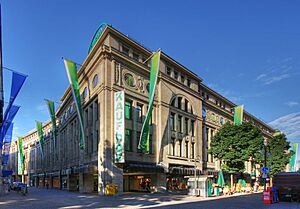
HBC bought the German department store chain Galeria Kaufhof and its Belgian part, Galeria Inno, in 2015 for $3.2 billion. In 2019, HBC sold its remaining shares of these companies. By August 2019, HBC announced that all 15 of its stores in the Netherlands would also be sold by the end of the year.
Neiman Marcus Group
On July 4, 2024, Hudson's Bay Company announced it would buy Neiman Marcus Group for $2.65 billion. This deal ended years of talks.
Company Closure
On March 7, 2025, Hudson's Bay filed for financial protection in Canada. This happened during a difficult time for retail. The company said it might not be able to pay its employees or rent. Many Hudson's Bay, Saks Fifth Avenue, and Saks Off 5th stores in Canada were expected to stay open at first.
However, later in March, HBC announced it would close 74 Hudson's Bay stores, 2 Saks Fifth Avenue stores, and all 13 Saks Off 5th stores in Canada. This put over 9,000 jobs at risk. Liquidation sales began on March 24, and stores were set to close permanently by June. On April 23, a court decided that the remaining six stores were unlikely to be bought, so HBC announced that all Hudson's Bay stores would close.
In early May, the company started looking for buyers for HBC's leases, brand names, and properties. The Heffel Gallery was chosen to auction off 1,700 pieces of art and 2,700 historical items, including the original 1670 royal charter. In July 2025, the Weston family agreed to pay $12.5 million for the royal charter to donate it to the Canadian Museum of History.
By June 1, 2025, all 80 Hudson's Bay stores, plus three Saks and 13 Saks Off 5th stores, had closed. By June 3, HBC had finished trying to sell its store leases. Many leases had no buyers and were returned to their landlords.
On June 3, it was announced that HBC's intellectual property rights were bought by Canadian Tire for $30 million. This included the Hudson's Bay name, trademarks, logos, coat of arms, and the famous stripes pattern. It also included slogans like Zellers's "Lowest price is the law."
How HBC Operated
HBC was involved in other businesses besides retail. It had credit card, mortgage, and personal insurance services, which were partnerships with other companies. HBC also had an HBC Rewards program, where customers could earn points to use in stores.
HBC also supported communities and charities. The HBC Rewards Community Program raised money for community causes. The HBC Foundation was a charity that worked on social issues. HBC used to sponsor the annual HBC Run for Canada, a running event on Canada Day that raised money for Canadian athletes. This event ended in 2009.
Olympic Outfitter

HBC was the official clothing supplier for the Canadian Olympic team in many years, including 1936, 1960, 1964, 1968, 2006, 2008, 2010, 2012, 2014, and 2016. This sponsorship was renewed until 2020. HBC used its role as the Olympic outfitter to gain global attention and improve its brand.
On March 2, 2005, HBC became the new clothing supplier for the Canadian Olympic team in a $100 million deal. The Canadian Olympic collection was sold through Hudson's Bay stores.
HBC's uniforms for the 2006 Winter Olympics and 2008 Summer Olympics received mixed reviews. Some thought the multi-colored stripes looked too much like HBC advertising instead of Canadian Olympic colors. Also, most of the Olympic clothes were made in China, which drew criticism because previous suppliers made their clothes in Canada.
HBC's clothing for the 2010 Winter Olympics in Vancouver was very popular, especially because Canada was the host country and won many medals. The red-and-white mittens with a maple leaf, sold for $10 with part of the money going to the Canadian Olympic Committee, were a huge hit. The "Canada" hoodies were also very popular.
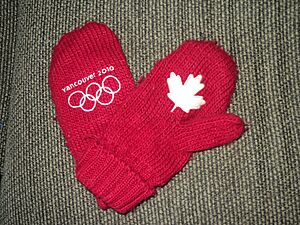
The HBC's 2010 Olympic apparel also caused some debate because of a machine-made sweater that looked like a traditional Cowichan sweater. HBC and the Cowichan Tribes reached an agreement, allowing Cowichan knitters to sell their sweaters alongside HBC's imitations.
Lord Sebastian Coe, who organized the 2012 London Olympics, noted how passionate Canadians were in supporting the Vancouver Games, wearing their "Canada" hoodies and red mittens. HBC continued to produce these red mittens for later Olympic Games.
In 2021, it was announced that Lululemon would replace HBC as Canada's Olympic outfitter starting with the 2022 Winter Olympics.
Company Records
HBC's history is well-preserved thanks to the detailed records the company kept. Before 1974, HBC's records were kept in its London office. In 1931, HBC opened its archives to researchers. In 1974, the Hudson's Bay Company Archives (HBCA) were moved from London to the Manitoba archives in Winnipeg. The public gained access to the collection the following year.
On January 27, 1994, the company officially donated its archives to the Archives of Manitoba. The records were valued at nearly $60 million. A foundation was created to support the HBCA and other programs. More than 2 kilometers of documents and hundreds of microfilm reels are now stored in a special climate-controlled vault.
In 2007, the Hudson's Bay Company Archives became part of the United Nations "Memory of the World Programme" project under UNESCO. The records cover HBC's history from its founding in 1670, including business deals, medical records, personal journals, and company reports.
Company Structure
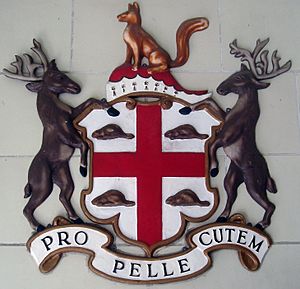
In the 1700s and 1800s, Hudson's Bay Company had a very strict employee structure. There were two main levels: officers and servants. Officers included factors, masters, chief traders, clerks, and surgeons. Servants included tradesmen, boatmen, and laborers.
Officers managed the fur trading posts. Their duties included supervising workers, valuing furs, and keeping records. After HBC merged with the North West Company in 1821, the structure became even stricter. Officers in charge of trading posts had a lot of responsibility. They had to make sure company rules were followed, even for fur prices. This strict but flexible system helped HBC succeed even with its main office far from its trading posts.
- Employee Ranks (1821–1871)
| # | Job Title | Pay per year |
|---|---|---|
| COMMISSIONED OFFICERS | ||
| 1 | Governor of Rupert's Land | Performance Pay |
| 2 | Chief Factor | Two shares |
| 3 | Chief Trader | One share |
| GENTLEMEN | ||
| 4 | Clerk | £75–100 |
| 5 | Apprenticed Clerk | £25–27 |
| NON-GENTLEMEN | ||
| 6 | Postmaster | £40–75 |
| 7 | Guide Interpreter Sloopmaster |
£30–45 |
| 8 | Apprentice postmaster | |
| SERVANTS | ||
| 9 | Tradesman Steersman Boatman Bowsman Middleman Labourer |
£16–40 |
Career Path
In the 1800s, officers usually started as fur traders. They hoped to become a Chief Trader, who managed a post and received a share of the company's profits. Chief Factors were higher up, leading districts and getting two shares of profits or losses.
Governors
Here is a list of the leaders (governors) of the Hudson's Bay Company:
- 1670–82 Prince Rupert of the Rhine
- 1683–85 James Stuart, Duke of York
- 1685–92 John Churchill, Earl of Marlborough
- 1692–96 Sir Stephen Evance
- 1696–1700 Sir William Trumbull
- 1700–12 Sir Stephen Evance
- 1712–43 Sir Bibye Lake
- 1744–46 Benjamin Pitt
- 1746–50 Thomas Knapp
- 1750–60 Sir Atwell Lake
- 1760–70 Sir William Baker
- 1770–82 Sir Bibye Lake Jr.
- 1782–99 Samuel Wegg
- 1799–1807 Sir James Winter Lake
- 1807–12 William Mainwaring
- 1812–22 Joseph Berens
- 1822–52 Sir John Henry Pelly
- 1852–56 Andrew Wedderburn Colvile
- 1856–58 John Shepherd
- 1858–63 Henry Hulse Berens
- 1863–68 Sir Edmund Walker Head
- 1868–69 John Wodehouse, 1st Earl of Kimberley
- 1869–74 Sir Stafford Henry Northcote
- 1874–80 George Joachim Goschen
- 1880–89 Eden Colvile
- 1889–1914 Donald Alexander Smith
- 1914–15 Sir Thomas Skinner
- 1916–25 Sir Robert Molesworth Kindersley
- 1925–31 Charles Vincent Sale
- 1931–52 Sir Patrick Ashley Cooper
- 1952–65 William "Tony" Keswick
- 1965–70 Derick Heathcoat-Amory
- 1970–82 George T. Richardson
- 1982–94 Donald S. McGiverin
- 1994–97 David E. Mitchell
- 1997–2006 L. Yves Fortier
- 2006–08 Jerry Zucker
- 2008 Anita Zucker
- 2008–present Richard Baker
Interesting Facts
Rent Obligation
Under its original charter, HBC had to give two elk skins and two black beaver pelts to the English king whenever the monarch visited Rupert's Land. This ceremony happened four times, with the last one in 1970 with Queen Elizabeth II. The Queen donated the two live beavers she received to the Winnipeg Zoo. When HBC moved its headquarters to Canada, this rent rule was removed.
Famous Explorers and Associates
Many important people were part of HBC's history:
- Henry Kelsey (1667–1724) was an English fur trader and explorer. He was the first European to see buffalo.
- Thanadelthur (c. 1697–1717) was a Chipewyan woman who guided and interpreted for HBC.
- Samuel Hearne (1745–1792) was an English explorer who built HBC's first inland trading post, Cumberland House, in 1774.
- David Thompson (1770–1857) was a British-Canadian fur trader and map-maker. He mapped almost half of North America.
- Thomas Douglas, Lord Selkirk (1771–1820) was a Scottish nobleman and a major shareholder in HBC. He helped establish a colony for Scottish immigrants at Red River.
- Isobel Gunn (c. 1780–1861) was a Scottish woman who pretended to be a man to work for HBC. She became the first European woman to travel to Rupert's Land.
- George Simpson (1787–1860) was the Canadian governor of HBC during its most powerful time.
- Donald Smith, 1st Baron Strathcona and Mount Royal (1820–1914) helped calm Louis Riel during the Red River Rebellion in 1870. He later became Governor of HBC.
- Dr. John Rae (1813–1893) was a Scottish doctor who explored Northern Canada and reported on the fate of the Franklin Expedition.
HBC Ships
HBC used many ships for trade and exploration. Here are some of them:
- Beaver (1835–1874)
- Otter (1852–1895)
- Anson Northup (1859–1860)
- Caledonia (1891–1898)
- Mount Royal (1902–1907)
- Princess Louise (1878–1883)
- Strathcona (1900)
- Distributor (1920–1948)
Rivals
HBC is the only European trading company from its time that still exists today. It outlasted all its competitors.
| Years | Company | Fate |
|---|---|---|
| 1551–1917 | Muscovy Company | Taken over by Soviet Russia and now operates as charity. |
| 1581–1825 | Levant Company | Closed down |
| 1600–1874 | Honourable East India Company | Closed down |
| 1602–1800 | Dutch East India Company | Went bankrupt and assets taken over by Dutch government |
| 1621–1791 | Dutch West India Company | Bought by the Dutch government |
| 1672–1752 | Royal African Company | Replaced by another company that later closed. |
| 1711–1850s | South Sea Company | Closed down due to bankruptcy and the Louisiana Purchase |
| 1779–1821 | North West Company | Merged with the HBC |
| 1799–1867 | Russian-American Company | Closed down with the sale of Russian America to the US. |
| 1808–1842 | American Fur Company | Closed down |
Interesting Facts About HBC
Rent Payment to the King
The original charter for Hudson's Bay Company had a special rule. The company had to give two elk skins and two black beaver pelts to the English king. This payment was due whenever the king or queen visited Rupert's Land.
The ceremony happened for the first time with the Prince of Wales in 1927. Then, with King George VI in 1939. The last times were with Queen Elizabeth II in 1959 and 1970. In 1970, the pelts were given as two live beavers. The Queen donated them to the Winnipeg Zoo. When HBC moved its main office to Canada, this rule was removed. All four "rent ceremonies" took place in or near Winnipeg.
Famous HBC Explorers and Builders
- James Knight (around 1640–1721) was an HBC leader and explorer. He died trying to find the Northwest Passage.
- Henry Kelsey (around 1667–1724) was an English fur trader and explorer. He helped establish HBC in Canada. In 1690, he was the first white person to see buffalo.
- Thanadelthur (around 1697–1717) was a Chipewyan woman. She was a guide and interpreter for HBC.
- Samuel Hearne (1745–1792) was an English explorer and fur trader. In 1774, he built Cumberland House. This was HBC's first trading post inland in what is now Saskatchewan.
- David Thompson (1770–1857) was a British-Canadian fur trader. He worked for both HBC and the North West Trading Company. He is famous for his explorations and map-making. He mapped almost half of North America.
- Thomas Douglas, Lord Selkirk (1771–1820) was a Scottish leader. He was a major owner of HBC. He bought land at Red River to start a colony for Scottish immigrants.
- Isobel Gunn (around 1780–1861) was a Scottish worker for HBC. She pretended to be a man. She was the first European woman to travel to Rupert's Land.
- George Simpson (1787–1860) was the Canadian governor of HBC. He led the company during its most powerful time, starting in 1821.
- Donald Smith, 1st Baron Strathcona and Mount Royal (1820–1914) was an important HBC leader. He helped calm things down during the Red River Rebellion in 1870. This allowed Rupert's Land to be transferred to Canada. He later became Governor of HBC.
- Dr. John Rae (1813–1893) was a Scottish doctor and explorer. He explored Northern Canada and parts of the Northwest Passage. He also reported what happened to the Franklin Expedition.
HBC Ships
- Beaver (1835–1874)
- Otter (1852–1895)
- Anson Northup (1859–1860)
- Caledonia (1891–1898)
- Caledonia (2) (1898–1909)
- Mount Royal (1902–1907)
- Princess Louise (1878–1883)
- Strathcona (1900)
- Port Simpson (1907–1912)
- Hazelton (1907–1912)
- Distributor (1920–1948)
HBC's Rivals: Who Survived?
HBC is the only European trading company from its time that still exists today. It outlasted all its competitors.
| Years | Company | What Happened |
|---|---|---|
| 1551–1917 | Muscovy Company | Taken over by Soviet Russia; now a charity. |
| 1581–1825 | Levant Company | Closed down. |
| 1600–1874 | Honourable East India Company | Closed down. |
| 1602–1800 | Dutch East India Company | Went bankrupt; assets taken by Dutch government. |
| 1621–1791 | Dutch West India Company | Bought by the Dutch government. |
| 1672–1752 | Royal African Company | Replaced by another company that later closed. |
| 1711–1850s | South Sea Company | Closed due to bankruptcy. |
| 1779–1821 | North West Company | Merged with the HBC. |
| 1799–1867 | Russian-American Company | Closed when Russian America was sold to the U.S. |
| 1808–1842 | American Fur Company | Closed down. |
See also
 In Spanish: Compañía de la Bahía de Hudson para niños
In Spanish: Compañía de la Bahía de Hudson para niños
- Beaver hat
- British colonization of the Americas
- Hudson's Bay Company vessels
- Hudson's Bay point blanket
- List of department stores in Canada
- List of Hudson's Bay Company trading posts
- Coat of arms of the Hudson's Bay Company
- Flag of the Hudson's Bay Company


